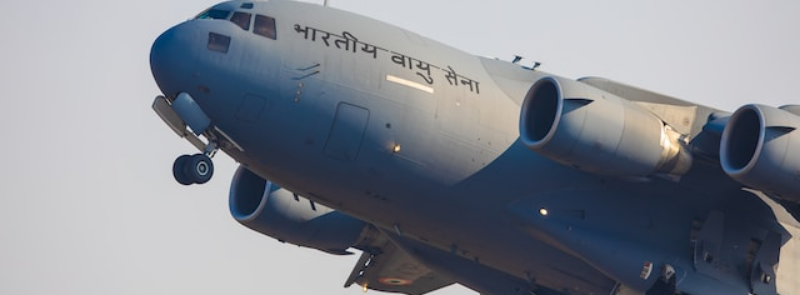
When It Occurs
Every October 8th
Timeline
Days Passed (813)
# Hashtags
#IndianAirForceDay #IAF
The formidable guardian of India's airspace, the Indian Air Force, was established as the 'Royal Indian Air Force' on October 8, 1932. This significant day is commemorated with elaborate parades and celebrations held nationwide.
It is a day dedicated to honoring the commitment, courage, and professionalism of the IAF personnel who safeguard India's skies. Furthermore, the Indian Air Force demonstrates its aerial prowess through spectacular air shows conducted at various locations across the country. The occasion is marked by a series of events, including aerial displays, rallies, parades, and ceremonies.
Historical Background:
- Indian Air Force was officially established on October 8, 1932, under British rule, as an auxiliary air force of the Royal Air Force (RAF). It was known as the Royal Indian Air Force (RIAF) until India became a republic in 1950, after which the "Royal" prefix was dropped.
- The IAF played a crucial role during World War II, especially in supporting British operations in Burma and defending India from Japanese forces.
- After independence in 1947, the IAF was pivotal in various operations during the Indo-Pakistani Wars, Kargil War, and numerous peacekeeping missions under the United Nations.
Significance of the Day:
- Indian Air Force Day celebrates the formation of the IAF and acknowledges its contribution to the country's defense and humanitarian efforts.
- It is an occasion to honor the air warriors, pilots, engineers, and all personnel who have served or are serving in the IAF.
- The day also serves as a reminder of the Air Force’s evolving role in maintaining the sovereignty of India's airspace and its strategic importance in modern warfare and security.
Celebrations and Events:
- Air Force Day Parade: The main event of Indian Air Force Day is the grand parade and air display held at the Hindon Air Force Station near Ghaziabad, Uttar Pradesh, which is the largest airbase in Asia. The parade includes a fly-past, aerobatic displays, and demonstrations by various aircraft in the IAF fleet, including fighter jets, transport aircraft, and helicopters.
- Aerobatics Teams: India's famed aerobatics teams, the Surya Kiran (flying Hawk aircraft) and the Sarang Helicopter Display Team (flying Advanced Light Helicopters - ALH), perform breathtaking stunts, showcasing precision flying and coordination.
- Static and Flying Displays: The event also features static displays of advanced aircraft, weaponry, and equipment used by the IAF. The flying display includes iconic jets such as Sukhoi Su-30MKI, Mirage 2000, MiG-21 Bison, and the indigenous Tejas Light Combat Aircraft (LCA).
- Wreath-Laying Ceremonies: Senior officials and air veterans participate in wreath-laying ceremonies to pay homage to the brave IAF personnel who lost their lives in the line of duty. This takes place at war memorials, with a special focus on their contribution to the nation's security and peace.
Key Roles of the Indian Air Force:
- Air Defense: One of the primary roles of the IAF is to protect the airspace of India. This involves monitoring, identifying, and intercepting any potential threats that enter the country's airspace.
- Strategic Operations: The IAF plays a vital role in strategic operations during wartime, including airstrikes, reconnaissance missions, and transportation of troops and supplies.
- Humanitarian Assistance: The IAF is actively involved in humanitarian missions, such as disaster relief operations during earthquakes, floods, or any other natural calamities. The IAF's transport and helicopter fleets are critical in reaching remote areas for rescue operations.
- Peacekeeping Missions: The IAF has been a part of various UN peacekeeping missions and international exercises, promoting global peace and cooperation.
Contributions in Wars:
- 1947 Indo-Pak War: The IAF provided essential air support to the Indian Army during the first Indo-Pakistani war over Kashmir.
- 1965 and 1971 Indo-Pak Wars: The IAF played a pivotal role in the 1965 war, showcasing air superiority. In the 1971 Bangladesh Liberation War, the IAF's contribution was crucial in ensuring India's victory and the creation of Bangladesh.
- Kargil War (1999): During the Kargil conflict, the IAF launched Operation Safed Sagar, deploying fighters, bombers, and helicopters in high-altitude warfare to support ground troops and target enemy positions in the Kargil-Dras sector.
Modernization and Growth:
The Indian Air Force has undergone significant modernization to enhance its operational capabilities. With the induction of advanced aircraft such as the Rafale, the indigenous Tejas, and ongoing upgrades to older platforms like Jaguar and MiG-29, the IAF is better equipped to handle modern challenges.
- Missile Systems: The IAF has also developed a sophisticated array of missile systems, including BrahMos and Astra air-to-air missiles.
- Space and Cyber Capabilities: The Air Force is increasingly involved in space and cyber operations, positioning itself as a critical component in India's defense ecosystem.
Inspirational Motto:
The IAF's motto, "Nabhah Sparsham Deeptam", is derived from the Bhagavad Gita and translates to "Touch the Sky with Glory." This phrase embodies the spirit of the Indian Air Force, highlighting their commitment to safeguarding India's airspace while upholding the highest standards of valor and service.
Conclusion:
Indian Air Force Day is a day of pride and reflection for India, celebrating the legacy, valor, and professionalism of the Indian Air Force. It also serves as an opportunity for the IAF to showcase its modern capabilities, achievements, and the critical role it plays in ensuring the nation's defense and security. The day is a reminder of the relentless efforts of the air warriors who protect India's skies and contribute to humanitarian missions worldwide.


